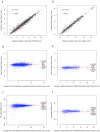A multimodal stacked ensemble model for cardiac output prediction utilizing cardiorespiratory interactions during general anesthesia
- PMID: 38553509
- PMCID: PMC10980739
- DOI: 10.1038/s41598-024-57971-6
A multimodal stacked ensemble model for cardiac output prediction utilizing cardiorespiratory interactions during general anesthesia
Abstract
This study examined the possibility of estimating cardiac output (CO) using a multimodal stacking model that utilizes cardiopulmonary interactions during general anesthesia and outlined a retrospective application of machine learning regression model to a pre-collected dataset. The data of 469 adult patients (obtained from VitalDB) with normal pulmonary function tests who underwent general anesthesia were analyzed. The hemodynamic data in this study included non-invasive blood pressure, plethysmographic heart rate, and SpO2. CO was recorded using Vigileo and EV1000 (pulse contour technique devices). Respiratory data included mechanical ventilation parameters and end-tidal CO2 levels. A generalized linear regression model was used as the metalearner for the multimodal stacking ensemble method. Random forest, generalized linear regression, gradient boosting machine, and XGBoost were used as base learners. A Bland-Altman plot revealed that the multimodal stacked ensemble model for CO prediction from 327 patients had a bias of - 0.001 L/min and - 0.271% when calculating the percentage of difference using the EV1000 device. Agreement of model CO prediction and measured Vigileo CO in 142 patients reported a bias of - 0.01 and - 0.333%. Overall, this model predicts CO compared to data obtained by the pulse contour technique CO monitors with good agreement.
© 2024. The Author(s).
Conflict of interest statement
The author declares no competing interests.
Figures






Similar articles
-
Comparison of the ability of two continuous cardiac output monitors to measure trends in cardiac output: estimated continuous cardiac output measured by modified pulse wave transit time and an arterial pulse contour-based cardiac output device.J Clin Monit Comput. 2016 Oct;30(5):621-7. doi: 10.1007/s10877-015-9772-x. Epub 2015 Sep 14. J Clin Monit Comput. 2016. PMID: 26370094
-
A preliminary study evaluating cardiac output measurement using Pressure Recording Analytical Method (PRAM) in anaesthetized dogs.BMC Vet Res. 2018 Mar 6;14(1):72. doi: 10.1186/s12917-018-1392-5. BMC Vet Res. 2018. PMID: 29510691 Free PMC article.
-
Measurement of cardiac output: a comparison between transpulmonary thermodilution and uncalibrated pulse contour analysis.Br J Anaesth. 2007 Sep;99(3):337-42. doi: 10.1093/bja/aem177. Epub 2007 Jul 4. Br J Anaesth. 2007. PMID: 17611251
-
Performance of a minimally invasive uncalibrated cardiac output monitoring system (Flotrac/Vigileo) in haemodynamically unstable patients.Br J Anaesth. 2008 Apr;100(4):451-6. doi: 10.1093/bja/aem409. Epub 2008 Feb 6. Br J Anaesth. 2008. PMID: 18256056 Review.
-
Semi-invasive measurement of cardiac output based on pulse contour: a review and analysis.Can J Anaesth. 2014 May;61(5):452-79. doi: 10.1007/s12630-014-0135-8. Epub 2014 Mar 19. Can J Anaesth. 2014. PMID: 24643474 Review.
References
-
- Ngo C. A simulative model approach of cardiopulmonary interaction. IFMBE Proc. 2015;51:1679–1682. doi: 10.1007/978-3-319-19387-8_408. - DOI
MeSH terms
LinkOut - more resources
Full Text Sources

